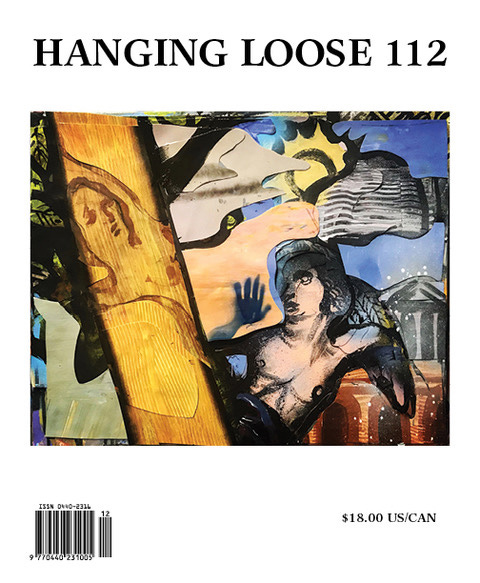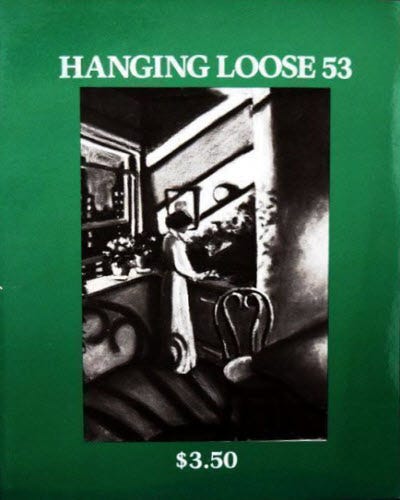Hanging Loose Magazine: Fifty-Six Years of Poetry & Nonconformity
A poetry magazine "for ordinary people"
Welcome to our weekly column offering perspectives on lit mag publishing, with contributions from readers, writers and editors around the world.
My prose has for years been mainly about other poets. It never occurred to me to write about a poetry magazine. Why write about the container when you could be writing about the contained?
Then I began reading Hanging Loose Magazine, founded by four William Carlos Williams disciples. A new window of intoxicated light flew open.
Hanging Loose, at first mimeographed and sent out into world with the addresses of its writers, so its readers could interact with them (a kind of snail mail Facebook), targeted an imagined literary everyman. It contained (and contains still) the poetry of high school students, together with the works of contemporary American masters, and somewhere along the way the poems of a farming refugee from the Oklahoma Dust Bowl. The literature of a poetry publishing democracy that has lasted more than half a century. A bit of lost innocence returned to the world.
Shortly before its first issue, Dick Lourie, 82, the sole-surviving founding member of Hanging Loose Magazine, was badgered by his cousin, Martha Scheiner, a New York high school student, into having him take a look at the poetry of her friend, Deborah Deichler, also a New York high school student.
“I was wowed by her work. Especially the poem ‘When You Are Trapped in Rabbit Grass.’ It was very short, conversational, deep, with a sense of peace, but also of disquiet. We decided to publish two of her poems in our first issue. In the same issue was the poetry of Denise Levertov. After that, we established a whole section to teenage poetry.”
In its current issue, number 112, fifty-six years later, the work of teenage poets still appear in its pages together with offerings by the prominent Marge Piercy and D Nurske.
Caroline Hagood, 36, who became the magazine’s first female editor in 2021, was one of its high school poets from St. Anne’s in Brooklyn, prompting Lourie to say, “Although we weren’t aware of it, we were building our own farm system.”
Hanging Loose, the Phoenix that rose up from the ashes of Things Magazine, was the creation of its former editors, Williams’ devotees Emmett Jarrett, Ron Schreiber, Lourie, plus recently deceased poet Bob Hershon. Things took its name from Williams’ famous: No ideas but in things.
Hanging Loose was part of the economically prudent “mimeograph revolution” of the late sixties. Its two yearly issues were stencil-typed and run off on a mimeograph machine. A labor-intensive production resembling literary factory work, editors and volunteers collated loose pages, stuffing them into professionally illustrated 6 x 9 envelopes and sending them out to subscribers.
Mark Pawlak, 76, who replaced Emmett Jarrett as editor in the late eighties, made the comment, “If you liked a poem you could tack it on the wall or give it to a friend. If you didn’t like a poem, you could toss it in the trash or use it as a napkin.”
Poetry removed from any sacred fire notions of future and tossed into the whim and scrim of the present moment. To bring poems into the world as loose hanging, disconnected things equal in their vulnerability to the vulnerability of ordinary people.
This freewheeling approach was not without risk. From the very first issue, editors included in the Table of Contents the writer’s addresses, so readers, if they wished, could connect with them. On one occasion, a prisoner (the magazine was given free to prisoners) sent a fan letter to a teenage author whose mother, a lawyer, demanded that the magazine end its practice of listing author’s addresses, which it did.
To bring poems into the world as loose hanging, disconnected things equal in their vulnerability to the vulnerability of ordinary people.
It was not until Issue 25 that Hanging Loose transitioned into a regular saddle-stitched magazine.
“Our mission,” Pawlak said, “was to support established writers who we felt deserved more attention, but even more, to discover new writers and give them an opportunity to find an audience. The democratic approach was part of our politics. We’ve always been open to women writers, multi-cultural voices, people of all ages.”
In Wilma McDaniel, Hanging Loose found a poet who checked off all of those boxes. An “Okie” who migrated with her family to California as a teenager during the Dust Bowl, Mc Daniel began sending the magazine her poems in her late-fifties. A student of Philip Levine, she’d write and submit her poems on scraps of paper. When she ran out of money for paper, she’d send her poems on the backs of church donation envelopes.
Hanging Loose wound up publishing four books of hers. It can boast of having launched a number of successful careers in poetry. Apart from McDaniel, Cathy Park Hong and D Nurske published their first books with Hanging Loose. It published Maggie Nelson’s first two books, and Kimiko Hahn’s first three books, and the books of the legendary Jayne Cortez who preferred to self-publish.
Sherman Alexie, its biggest success story, first heard about Hanging Loose as a student at the University of Washington. His poetry professor dispatched his students to the library to choose three magazines to which to submit their work. One of Alexie’s three was Hanging Loose.
His first batch of poems was rejected with an encouraging letter. A week later, he sent off a second batch that was accepted. Eventually, they published his first volume, The Business of Fancy Dancing, which got a review in The New York Times, and sold an unheard of 40,000 copies.
Always eclectic in the poetry it chose, the magazine began by publishing a lot of poems influenced by Williams, moving on later to second generation poets from the New York School like Charles North and Paul Violi. They were one of the first US publications to run the abstract contemplative poems of the expatriate mystic Robert Lax. Jarrett traveled all the way to the Greek island of Patmos to meet with him.
“The one thing you notice is how many funny poems they publish,” said Hanging Loose poet Joanna Fuhrman, who is quite funny herself. “Also, the spoken has always been really important to them. In the Sixties, there were poets who were associated with the New American Poetry (Don Allen edited the widely read New American Poetry 1945-1960.) as compared to poets who were academic. Hanging Loose was more associated with the shaggy aesthetics that came out of the New American Poetry.”
The magazine has to be one of the last to read only mailed-in manuscripts, and to refrain from publishing online. That has not changed, nor is it likely to any time soon, even with the addition of younger, computer savvy editors and poets. Jiwon Choi, 52, a recent addition to the editorial staff, says emphatically, “I am committed to the paper edition. It has its value in a world where everything is digitized and online.”
Hanging Loose celebrates poetry with its hereditary anarchy that has managed to withstand time and the digital revolution, while managing to navigate the eternal mystery of small publishing solvency. Its appearance on the often dry, overly serious landscape of poetry evokes the same sort of sly, insurrectionary delight as a Frank O’ Hara poem.








Hi Doug:
HL has a small staff. I have to wait months before hearing back from them. I read back issues of HL at Poets House and was struck by their diversity and history. Yes, not being online is
restrictive. I am OK with it. It has the flavor of pre-cyber anarchy. I like its style. But I see what you
mean. Do you live here in the city. Poets House should reopen in a few months
Great article! Very inspiring and I too, agree with the people at Hanging Loose that paper existence is important in this world where everything seems so temporary and fleeting